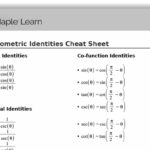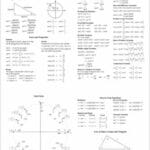Decoding the Ambiguous Case
Ever tried to build a triangle knowing only two sides and an angle not between them (SSA)? It’s like trying to prop up a wobbly table with only two legs – sometimes it works, sometimes it’s impossible, and sometimes, surprisingly, there are two solutions! This is the ambiguous case of the Law of Sines. It arises because the sine function has two angles between 0° and 180° that produce the same sine value. This means when we use the Law of Sines to find an angle, we might have two possible angles that seemingly fit.
The Altitude Test: Your Triangle’s Sorting Hat
Imagine dropping a line (the altitude, ‘h’) from the vertex of the known angle (A) perpendicular to the opposite side (or its extension). Calculating ‘h’ (h = b*sin(A)) helps determine the number of possible triangles.
Checking the Possibilities
Comparing side ‘a’ (opposite angle A) to ‘h’ and ‘b’ reveals the following scenarios:
- a < h: No triangle exists. Side ‘a’ is too short to reach the base.
- a = h: One right triangle exists. Side ‘a’ perfectly meets the base, forming a right angle.
- a > b: One triangle exists. Side ‘a’ swings past side ‘b’, forming a single triangle.
- h < a < b: Two triangles exist. Side ‘a’ can intersect the base in two different locations.
This table summarizes the possibilities:
| Scenario | Relationship | Number of Triangles |
|---|---|---|
| a < h | Side ‘a’ is shorter than altitude ‘h’ | 0 |
| a = h | Side ‘a’ equals altitude ‘h’ | 1 (a Right Triangle) |
| a > b | Side ‘a’ is longer than side ‘b’ | 1 |
| h < a < b | Altitude ‘h’ is less than side ‘a’, which is less than side ‘b’ | 2 |
Applying the Law of Sines
Once the altitude test reveals the number of possible triangles, use the Law of Sines (a/sinA = b/sinB = c/sinC) to find the missing parts. If two solutions exist, calculate both possible values for angle B (the acute angle found directly and its obtuse supplement, 180° – B).
Real-World Implications
The ambiguous case has practical applications in fields like surveying, navigation, and engineering. For instance, a surveyor might use the Law of Sines to determine the distance to a landmark. The ambiguous case may suggest two possible locations, requiring further information for accurate pinpointing. Similar situations, involving “two sides and a non-included angle triangle ambiguity,” or needing “SSA triangle solutions,” arise in other fields requiring precise measurements. This is further explored in resources like It’s Your Ship Michael Abrashoff and Strengths Finder Tom Rath, which offer insights into problem-solving and decision-making.
What is the ambiguous case for the law of sines?
The ambiguous case occurs when we know two sides of a triangle and an angle not between them (SSA). This setup is ambiguous because it can lead to zero, one, or even two possible triangles. The ambiguity stems from the fact that two different angles can have the same sine value. This is particularly relevant when analyzing “SSA triangle solutions.”
The Height Test: Does a Triangle Exist?
The height (h) of the triangle, calculated using h = b*sin(A), determines if a triangle can be formed:
- a < h: No triangle is possible.
- a = h: One right triangle is possible.
- h < a < b: Two triangles are possible.
- a ≥ b: One triangle is possible.
| Scenario | Number of Triangles |
|---|---|
| a < h | 0 |
| a = h | 1 (Right Triangle) |
| h < a < b | 2 |
| a ≥ b | 1 |
Solving for Angles
When two triangles are possible, using the Law of Sines to find an angle (e.g., B) might yield two valid results: an acute angle (B) and its obtuse supplement (180° – B).
Real-World Significance
The ambiguous case is important in navigation, surveying, and engineering. For surveyors, encountering the ambiguous case when determining distances may suggest multiple locations, highlighting the need for additional data.
What is the sine rule ambiguous case lesson?
The ambiguous case of the sine rule occurs when we know two sides and a non-included angle (SSA). It can produce zero, one, or two possible triangles.
Why is it Ambiguous?
The sine function’s cyclical nature means two different angles can have the same sine value. This creates ambiguity when using the inverse sine function to find an angle.
Six Possible Scenarios:
Let ‘a’ be the side opposite the known angle ‘A’, and ‘b’ be the other given side:
- a < b*sin(A): No triangle.
- a = b*sin(A): One right triangle.
- b*sin(A) < a < b: Two triangles.
- a > b: One triangle.
- A ≥ 90° and a > b: One triangle.
- A ≥ 90° and a ≤ b: No triangle.
Solving the Ambiguous Case:
- Calculate b*sin(A).
- Compare ‘a’ to b*sin(A) and ‘b’.
- If possible, use the Law of Sines.
- If two triangles exist, find the second angle (180° – B).
- Verify angles (A + B + C < 180°).
Practical Uses:
The ambiguous case is important in navigation, surveying, and engineering. A surveyor using the Law of Sines might find two possible locations for a landmark, demonstrating the need for more information.
How to determine the number of triangles in an ambiguous case?
When presented with two sides and a non-included angle (SSA), the ambiguous case might give you zero, one, or two possible triangles. Here’s how to figure out which scenario you’re dealing with:
The Height Test:
The triangle’s height (h = b*sin(A)) is key. Comparing side ‘a’ to ‘h’ and ‘b’ determines the number of triangles:
- a < h: No triangle.
- a = h: One right triangle.
- h < a < b: Two triangles.
- a ≥ b: One triangle.
| Scenario | Comparison | Number of Triangles |
|---|---|---|
| 1 | a < h | 0 |
| 2 | a = h | 1 (right triangle) |
| 3 | h < a < b | 2 |
| 4 | a ≥ b | 1 |
Solving with the Law of Sines:
After determining the number of possible triangles, use the Law of Sines to find the missing sides and angles. In the two-triangle scenario, remember there will be two possible values for the angle opposite ‘b’ – an acute angle and its obtuse supplement. This is crucial when addressing “law of sines ambiguous case” problems.
Real-World Applications:
This isn’t just theoretical. Surveyors, engineers, and navigators use these principles. Imagine a surveyor trying to measure the distance across a canyon. They might know two distances and one angle, and need to figure out if their measurements are giving them one unique answer, two possible answers, or no answer at all. This relates directly to the “law of sines ambiguous case” scenario. Understanding this concept can also be useful in other contexts, such as exploring leadership styles in It’s Your Ship Michael Abrashoff or identifying personal strengths with Strengths Finder Tom Rath. Both resources emphasize the importance of accurate assessment and making informed decisions based on the information available.
- Red Cloud, NE: Discover Willa Cather’s Legacy - April 11, 2025
- Remember Old Social Media Sites? Their Rise and Fall - April 11, 2025
- How many days till Feb 3?Accurate Countdowns & Tools - April 11, 2025

















1 thought on “Mastering the Ambiguous Case of the Law of Sines: When Two Triangles Are Better Than One (Or None!)”
Comments are closed.